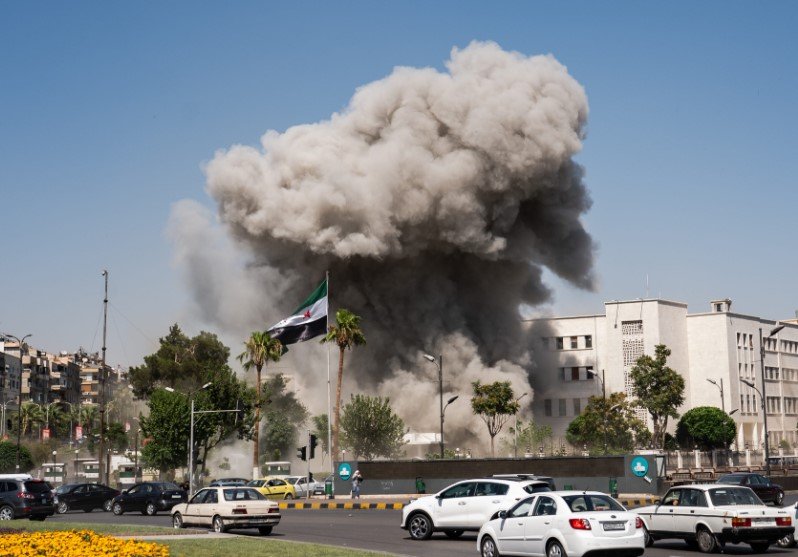White House scrambles after Jerusalem targets Damascus and Sweida amid rising tensions in southern Syria
Donald Trump isn’t used to being left out of the loop — especially not by Israel. But that’s exactly what happened last week, according to officials inside the White House, after Israeli warplanes pounded parts of Syria without prior notice to Washington.
The strikes hit the capital Damascus and the southern city of Sweida, home to Syria’s minority Druze population, prompting a flurry of backchannel calls between U.S. and Israeli leaders. The president, aides say, was “caught off guard” — and not too pleased.
An Ally Acts Solo, and the Fallout Follows
The Israeli strikes came late Thursday, rattling windows in Damascus and flattening suspected military targets in Sweida — a city already rattled by days of unrest between Druze fighters and pro-Assad militias.
Israel, according to its military, aimed to apply pressure on the Syrian regime to withdraw troops from southern regions, where intelligence suggested growing Iranian entrenchment. But no heads-up was given to Washington, despite the proximity of U.S. operations in eastern Syria and ongoing diplomatic efforts to keep regional tensions from boiling over.
“The President was not informed in advance,” said a White House official, speaking on condition of anonymity. “He made clear to Prime Minister Netanyahu that coordination is essential, especially at this stage.”
The official confirmed Trump called Netanyahu hours after the attack, urging Israel to “rectify the situation.” The language was vague — perhaps intentionally.

Sweida on Edge, and Washington Watches Closely
Sweida isn’t a household name outside the Middle East. But within Syria, it’s a symbolic flashpoint. The city, largely populated by the Druze minority, has managed to stay semi-autonomous throughout much of the 13-year civil war.
In recent months, however, clashes have erupted between local Druze militias and Syrian regime troops over forced conscriptions, fuel shortages, and government crackdowns. That unrest appears to have drawn Israel’s eye — and its missiles.
A spokesperson for the Israel Defense Forces said last Friday the strikes targeted “military infrastructure used by Iranian and Syrian regime forces in planning attacks on Israel and its allies.”
But locals told a different story.
“We heard the jets around midnight. Then a boom — and everything shook,” said Nabil, a pharmacist in Sweida, who asked that only his first name be used. “People are angry. This isn’t just about Assad or Iran anymore. It’s about survival.”
Trump’s Syria Policy: Thin Lines and Mixed Messages
For Trump, who has campaigned on an “America First” foreign policy and boasted about dialing back Middle East wars, the Israeli escalation couldn’t have come at a worse time.
His administration has repeatedly tried to walk a tightrope — supporting Israel’s right to self-defense while trying to limit U.S. entanglement in Syria. But that approach is fraying, particularly as Israeli strikes risk drawing American troops into broader regional fights.
And the messaging hasn’t helped.
-
In early July, Trump told supporters at a Michigan rally that he “won’t be dragged into another forever war.”
-
But just days later, U.S. forces carried out air patrols over eastern Syria after Iranian proxies fired rockets near American bases.
-
Now, with Israel striking southern Syria without coordination, the tightrope is swaying.
“You can’t have your closest ally freelancing air raids next to your troops and think it won’t backfire,” said Aaron David Miller, a former State Department adviser on the Middle East. “Trump knows this, but he’s also boxed in politically.”
Netanyahu’s Calculus: Pressure, Distraction, or Both?
Back in Jerusalem, Netanyahu has his own reasons for flexing muscle in Syria. His government — the most right-wing in Israel’s history — is under immense pressure at home over economic woes, corruption trials, and unrest along the Gaza border.
Some analysts believe the Syria strikes served more than a tactical purpose.
“Netanyahu wants to remind voters and enemies alike that Israel won’t tolerate Iranian build-up in Syria,” said Yael Mizrahi-Arnaud, a senior fellow at Tel Aviv’s Institute for National Security. “But doing it without the Americans onboard? That’s unusual — and risky.”
Indeed, while Israel routinely strikes targets in Syria linked to Hezbollah or Iranian units, it typically shares intelligence with Washington ahead of time. The fact that it didn’t last week raised eyebrows, especially inside the Pentagon.
The Bigger Picture: Iran, Russia, and the Syria Wild Card
Beyond the headlines, Syria remains a tangled chessboard — with Iran, Russia, Turkey, the U.S., and various rebel groups all vying for influence.
Since the October 2023 Gaza war, Israel has escalated its campaign against Iranian positions in Syria, particularly near the Golan Heights and Damascus International Airport. But with Russian troops still stationed across much of Syria’s west and Iranian militias entrenched in the south, any miscalculation could spiral.
Trump has tried to avoid just that. His 2024 campaign promises included a pledge to reduce U.S. troops in the region by at least 30%. But reality has complicated that pledge. Some 900 American soldiers remain in Syria — mostly near oil fields in the northeast — and recent tensions with Iranian-backed militias have made withdrawal politically fraught.
And then there’s the broader optics: Trump doesn’t want to appear weak in the face of Middle East chaos, especially as he heads into a general election year.
Will There Be Consequences?
For now, the White House says the phone call with Netanyahu “clarified expectations” and that the U.S. expects “better coordination going forward.”
But Israeli officials have given no indication they plan to slow their operations in Syria. One defense source, speaking to Israel’s Channel 13, put it bluntly: “We will act when we must. The Americans understand that, whether they agree or not.”
That’s not likely to soothe nerves in Washington — or on the ground in Syria. With violence flaring again in Sweida, protests spreading to nearby towns, and reports of new militia mobilizations, the region feels poised on a knife’s edge once more.
